Emergency Medicine > EXAM > NRP 2022 exam/ NRP 7TH EDITION Parts 1 and 2 answered and graded 100% score. (All)
NRP 2022 exam/ NRP 7TH EDITION Parts 1 and 2 answered and graded 100% score.
Document Content and Description Below
NRP 7TH EDITION Test questions Sections 1 and 2 After the initial steps of newborn care, a baby is apneic. What is the most important and effective action to take in the resuscitation of this baby?... Provide positive-pressure ventilation. Perform chest compressions. Provide additional vigorous stimulation Provide supplemental oxygen. During the resuscitation of a newborn, you auscultate the apical pulse and count 10 beats over a 6 second period. What heart rate do you report to your team? 60 beats per minute 120 beats per minute 100 beats per minute 30 beats per minute A newborn of 34 weeks' gestation is not breathing (apneic) at birth, does not respond to initial steps and requires positive-pressure ventilation. What concentration of oxygen should be used as you begin positive-pressure ventilation? 30 - 50% oxygen 100% oxygen 50 - 70% oxygen 21 - 30% oxygen You are at the resuscitation of a newborn who is gasping and has a heart rate of 60 beats per minute. What is the most important action you can take? Provide chest compressions Apply CPAP Provide positive-pressure ventilation Provide free-flow oxygen What is the most effective maneuver to establish spontaneous breathing in a baby that is apneic after initial steps? Continued rubbing of the back Administration of free-flow oxygen Administration of positive-pressure ventilation that inflates the lungs Application of CPAP Remembering MR. SOPA helps your team correct problems with ventilation. Which of the following steps are included in MR. SOPA? Adjust Mask and Reposition head and neck; Suction mouth then nose and Open the mouth; increase Pressure; insert Alternative airway. Mouth opened, Reposition head, Saturation check, Obstruction check, Pulse oximeter sensor, Apply cardiac monitor leads. Ensure Mask seal, Repeat stimulation, Suction the airway, Oxygen regulation, Pulse oximeter sensor, Assess heart rate. Mouth opened, Repeat stimulation, Saturation check, Occlude pop-off valve, Perfusion check, Auscultate breath sounds. A baby is born at 34 weeks' gestation. After the initial steps of resuscitation, the baby is not breathing (apneic). What are the next steps? Provide additional tactile stimulation, evaluate color and tone, evaluate heart rate. Administer free-flow oxygen, place a pulse oximeter sensor on the right hand or wrist, evaluate heart rate. Administer CPAP, place a pulse oximeter sensor on the right hand or wrist, evaluate color and tone. Initiative positive-pressure ventilation, place a pulse oximeter sensor on the right hand or wrist, evaluate heart rate. You are called to attend to a newborn at birth. At the time the baby is delivered, which 3 questions should you ask to evaluate whether the baby can stay with his mother or be moved to the radiant warmer for further assessment? Is the baby warm? Does the baby have good tone? Is the baby full-term? Is the amniotic fluid clear? Is the baby breathing or crying? Is the baby of low birth weight? Is the baby pink? Is the baby breathing or crying? Is the amniotic fluid clear? Is the baby term? Does the baby have good muscle tone? Is the baby breathing or crying? A full-term baby is born by emergency cesarean delivery because of fetal bradycardia (Category III fetal heart rate tracing). The baby is limp and not breathing after initial steps. What is the next step in the resuscitation process? Initiate positive-pressure ventilation and check for increasing heart rate Continue stimulating the baby for an additional 30 seconds Initiate chest compressions using the 2-thumb technique Provide free-flow oxygen, and begin chest compressions. What is the recommended way to determine if a baby requires supplemental oxygen in the delivery room? Place an oximeter sensor on the baby's right hand or wrist and assess oxygen saturation. Assess the color of the baby's chest and abdomen, and monitor for central cyanosis. Assess the color of the baby's hands and feet. Send an arterial blood gas, and evaluate the partial pressure of oxygen. You have been called to attend a birth and are the only healthcare provider responsible for the management of the newborn in the room. When should you first call for additional help? After birth, when you determine the baby requires intubation. Before birth, when you have identified the presence of a perinatal risk factor that increases the likelihood of requiring neonatal resuscitation. After birth, when you determine the baby requires positive-pressure ventilation. After birth, when the obstetrician or labor nurse suggests you need additional help. - Effective team functioning is critical in ensuring the best performance. Which of these characteristics is critical in team leaders? They should never allow team members to participate in decision-making. They should be able to maintain situational awareness. They should be solely responsible for assessment and planning. They must take on several jobs at the same time to ease the team's work. You are part of a team preparing for the birth of a baby who has meconium-stained fluid and a category III fetal heart rate tracing. A person skilled in endotracheal intubation should be Available from a remote location in the hospital. Not necessary if a team member knows how to place a laryngeal mask. Called in from home when the baby is born and then requires intubation. Present at the birth. Your team attends an emergency cesarean delivery of a term baby because of chorioamnionitis, meconium-stained amniotic fluid, and fetal heart rate decelerations. At delivery, the newborn is term as expected, with very poor tone and he is not breathing (apneic). You quickly perform initial steps, but the newborn is still not breathing. What is the most appropriate next step of resuscitation? Start positive-pressure ventilation and check heart rate response after 15 seconds. Intubate and administer 0.05 mg/kg of endotracheal epinephrine. Immediately intubate and suction the trachea. Start cardiac compressions coordinated 3:1 with ventilation, and prepare to insert an umbilical venous catheter. Your hospital is planning Neonatal Resuscitation Program® training and trying to decide who should be included. For every delivery, what is the minimum requirement for the care of the newborn at birth? Someone capable of initiating neonatal resuscitation should be present at every delivery whose only responsibility is the management of the newborn. Someone capable of initiating neonatal resuscitation should be available in the hospital to be called after birth. Someone capable of initiating neonatal resuscitation should be present only if risk factors are identified. Someone capable of initiating resuscitation should be available on call from home to respond if there is a problem with the newborn. Which statement describes recommended practice when using a pulse oximeter in the delivery room? Place the pulse oximeter sensor on the right hand and use the minute specific oxygen saturation target to guide oxygen supplementation. Place the pulse oximeter sensor on the right foot and use the minute specific oxygen saturation target to guide oxygen supplementation. Place the pulse oximeter sensor on the right hand and adjust the oxygen concentration to achieve 100% oxygen saturation. Place the pulse oximeter sensor on the right foot and adjust the oxygen concentration to achieve 100% oxygen saturation. You have started positive-pressure ventilation for a newborn because her heart rate is low (bradycardia). What is the most important indicator of successful positive-pressure ventilation? A rising heart rate Chest movement with each breath Improvement in tone and movement Audible and bilateral breath sounds What is the appropriate technique to stimulate a baby to breathe? Gently rub the baby's back or extremities Hold the baby upside down and gently pat the buttocks Vigorously suction the oropharynx with a bulb syringe Apply free-flow oxygen to the baby's face Which of the following is an indication for endotracheal intubation? The presence of meconium-stained amniotic fluid on the skin of a vigorous newborn All premature newborns less than 30 weeks' gestation The need for positive-pressure ventilation lasting more than a few minutes The need to administer CPAP A baby is born at term with a bilateral cleft lip and palate and a very small mandible. She requires positive-pressure ventilation because she is not breathing. You are unable to achieve a seal with bag and mask. Which intervention is indicated? Insert a laryngeal mask Place an orogastric tube Administer CPAP Attempt endotracheal intubation multiple times You are uncertain whether you have successfully intubated a newborn. Which of the following is an indication that the endotracheal tube is correctly placed in the trachea, and not in the esophagus? Air is heard entering the stomach CO2 detector indicates the presence of expired CO2 Grunting respirations can be heard Continued cyanosis and bradycardia You have determined a baby needs resuscitation at birth. What are the initial steps of newborn care? Provide warmth, position head and neck to open the airway, clear secretions from the airway if needed, dry, stimulate Provide warmth, clear secretions with a suction catheter, evaluate the baby's color, and evaluate heart rate Position head to open the airway, dry, stimulate, evaluate the baby's color Provide warmth, position head to open airway, evaluate the baby's color The steps of intubation should ideally be completed within which duration? 30 seconds 60 seconds 40 seconds 90 seconds Which statement best describes normal transitional physiology at the time of birth? Babies may take as long as 10 minutes after birth to increase their oxygen saturation to greater than 90%. Oxygen saturation by pulse oximetry is unreliable in the newborn, and 100% oxygen is recommended immediately after birth. Visual assessment of cyanosis is a reliable indicator of the baby's oxygen saturation. The oxygen saturation normally rises to at least 90% by 2 minutes of age. You are at a delivery of a baby born through meconium-stained amniotic fluid, and the baby is not vigorous. What steps should be taken immediately after birth? The baby should be brought to the radiant warmer and her trachea should be immediately intubated and suctioned. The baby should stay with her mother for routine newborn care. The baby should stay with her mother and have oral secretions cleared with a suction catheter. The baby should be brought to the radiant warmer for initial steps of newborn care. - The baby should be brought to the radiant warmer for initial steps of newborn care. Which of the following may be associated with delayed cord clamping in vigorous preterm newborns? Increased intraventricular hemorrhage Decreased blood pressure Decreased need for blood transfusions Increased incidence of necrotizing enterocolitis When are chest compressions indicated? When the heart rate remains less than 100 beats per minute despite positive-pressure ventilation with 100% oxygen. When the heart rate remains less than 60 beats per minute after 30 seconds of positive-pressure ventilation that moves the chest, preferably through an alternative airway. When the heart rate is less than 80 beats per minute. When the heart rate remains less than 100 beats per minute after 30 seconds of positive-pressure ventilation that moves the chest, preferably through an alternative airway. A baby required ventilation and chest compressions. After 60 seconds of chest compressions, the electronic cardiac monitor indicates a heart rate of 70 beats per minute. What is your next action? Stop chest compressions; continue positive-pressure ventilation. Administer epinephrine while continuing chest compressions and positive-pressure ventilation with 100% oxygen. Stop chest compressions and stop positive-pressure ventilation. Continue chest compressions and continue positive-pressure ventilation. What is the preferred method for assessing heart rate during chest compressions? Electronic cardiac (ECG) monitoring Palpate the umbilical cord Pulse oximeter reading on the right hand or wrist Auscultate with a stethoscope What is the ideal depth of chest compressions for a newborn? One-fourth of the anterior-posterior diameter of the chest One-third of the anterior-posterior diameter of the chest Half of the anterior-posterior diameter of the chest Two-thirds of the anterior-posterior diameter of the chest What time frame should be used to administer intravenous epinephrine? Rapid push, as quickly as possible Over 5 to 10 minutes Over 1 to 2 minutes Over 3 to 5 minutes Which of the following is the best indication for volume expansion after resuscitative efforts that included intubation, chest compressions, and IV epinephrine? The baby's heart rate remains 50 beats per minute after resuscitative efforts and pulses are weak. The baby's heart rate is 120 beats per minute after resuscitative efforts, but she is very pale. The baby's heart rate is 120 beats per minute after resuscitative efforts and there is a history of extensive vaginal bleeding during labor. The baby's heart rate rapidly increased to 120 beats per minute with epinephrine, but her pulses seem weak. Which statement best describes the ethical principle(s) that guide the resuscitation of a newborn? The ethical principles of beneficence, non-maleficence, autonomy, and justice are used for adults and older children, but they do not apply to newborns. The baby is a minor and all decisions regarding resuscitation should be made during an emergency meeting of the hospital ethics committee. The approach to decisions in the newborn should be guided by the same principles used for adults and older children. All decisions regarding resuscitation are made by the health care providers, and parents do not participate in decision making. When coordinating positive-pressure ventilation with chest compressions, how many events are performed each minute? 60 breaths, 120 compressions 40 breaths, 80 compressions 60 breaths, 60 compressions 30 breaths, 90 compressions Which of the following statements about post-resuscitation care is true? All babies with prenatal and intrapartum risk factors for resuscitation must be removed from their mother's room and observed in a nursery setting. Babies who required resuscitation after birth should be bathed immediately to stimulate breathing and decrease the risk of low body temperature (hypothermia). Babies who required positive-pressure ventilation after delivery rarely require additional respiratory support and do not need additional assessment and monitoring. Among babies with brain injury from decreased oxygen and blood flow to the brain (hypoxic-ischemic encephalopathy), high body temperature (hyperthermia) may worsen neurologic outcomes. You are in the delivery room caring for a preterm newborn at 27 weeks' gestation. The baby is 5 minutes old and breathing spontaneously. The baby's heart rate is 120 beats per minute and the oxygen saturation is 90% in room air. The baby's respirations are labored. Which of the following is an appropriate action? Provide vigorous stimulation on the back, trunk, and extremities Provide supplemental oxygen to rapidly increase the baby's oxygen saturation above 95% Administer positive-pressure ventilation with an initial inflation pressure of 30 to 35 cm H20 Administer CPAP at 5 cm H20 pressure How soon after administration of intravenous epinephrine should you pause compressions and reassess the baby's heart rate? 10 to 16 seconds 5 minutes 1 minute 30 seconds After what duration of time might it be reasonable to consider discontinuing resuscitation following complete resuscitation efforts with no detectable heart rate? 10 minutes 20 minutes 5 minutes 30 minutes A mother had an emergency cesarean birth at 39 weeks' gestational because of sudden fetal bradycardia and a suspected placental abruption. After birth, the baby required extensive resuscitation including positive pressure ventilation, intubation, chest compressions and intravenous epinephrine. Afterward, the baby has poor tone, lethargy, and apnea. Which of the following statements is true? Administer 100% oxygen and sodium bicarbonate to prevent pulmonary hypertension. Promptly start formula feeding to avoid low blood glucose (hypoglycemia) and electrolyte abnormalities. Discourage the mother from pumping and storing breast milk because it is unlikely that she will be successful. Promptly evaluate her for possible therapeutic hypothermia (cooling) treatment and contact the nearest cooling center. - A baby's heart rate does not increase after intubation and the breath sounds are louder on the right side than the left side of the chest. Which of the following is a common cause of asymmetric breath sounds in an intubated baby? Endotracheal tube inserted too deep Neck mass Oral mass Robin sequence During resuscitation, a baby is responding to positive-pressure ventilation with a rapidly increasing heart rate. Her heart rate and oxygen saturation suddenly worsen. She has decreased breath sounds on the left side and transillumination also reveals a bright glow on the left side. What is the most likely cause of this distress? Left-sided pneumothorax Displacement of endotracheal tube from the trachea into the esophagus Choanal atresia Obstruction of the endotracheal tube with thick secretions For a newborn weighing 1 kg, what dose of 1:10,000 (0.1 mg/mL) concentration of intravenous epinephrine is indicated? 5 mL 1 mL 0.5 mL 0.1 mL In most cases, who is (are) the usual and appropriate surrogate decision maker(s) for a newborn? The newborn's parents The hospital chaplain The hospital ethics committee The members of the health care team When a newborn has a high risk of mortality and there is a significant burden of morbidity among survivors, what should be included in your discussion with the parents concerning options for resuscitation? The hospital ethics committee must be consulted to make a decision. The resuscitation team alone will make the appropriate decision after birth. No resuscitation will be started under any circumstances. The option of providing comfort care can be considered. A baby born at 36 weeks' gestation was apneic after birth and required positive-pressure ventilation and oxygen supplementation in the delivery room. He continues to require supplemental oxygen after birth. Which of the following statements is true? If he has continuing respiratory distress, sodium bicarbonate should be infused immediately. His parents should be discouraged from seeing or touching him after birth because it may agitate him and cause additional complications. His blood pressure does not need to be monitored because hypotension (low blood pressure) does not occur after resuscitation. His blood glucose level should be checked soon after resuscitation and then at regular intervals until stable and normal. You are in the delivery room caring for a preterm newborn at 27 weeks' gestation. Resuscitation has been completed and the baby is ready to be transported to the neonatal intensive care unit. Which of the following is a true statement about the baby's subsequent care? Apnea and bradycardia are uncommon, self-limited and no monitoring is required. Monitor blood glucose levels because of the risk of hypoglycemia after birth. Maintain the baby's body temperature above 38 ºC (100.4 ºF). Position the baby's legs higher than the baby's head (Trendelenburg position) to decrease the chance of neurologic injury. After chest compressions with coordinated ventilations are started, the heart rate should be assessed: After 60 seconds After 90 seconds When spontaneous respirations return After 30 seconds A newborn requires complex resuscitation. You have intubated and are administering positive-pressure ventilation and chest compressions. Which 3 signs are used to evaluate the effectiveness of your actions, and the need to continue one or both of these measures? Respirations, blood pressure, oxygen saturation Blood pressure, oxygen saturation, heart rate Respirations, blood pressure, heart rate Respirations, heart rate, oxygen saturation A woman is admitted at 24 weeks' gestation with rupture of membranes, maternal fever, and premature labor. The care team offers the parents counseling. What is likely to be helpful? Assure parents that you can accurately determine the baby's prognosis immediately after birth. Wait to speak with mother until she has received a sedative to relieve her anxiety. The obstetric provider and neonatologist should meet separately with the parents because of their different perspectives. Provide parents with accurate prognostic information using all relevant information affecting their baby's prognosis. Which of the following is true about the preparation and resources needed for a very preterm birth? The delivery room temperature should be decreased to approximately 65ºF to 66ºF (18.3ºC to 18.8ºC). A size-1 laryngoscope and size 3.5-mm endotracheal tube should be prepared for the initial intubation attempt. Personnel skilled in intubation and umbilical catheter placement may be on call at home. Prepare the preheated radiant warmer with a thermal mattress, plastic wrap or bag, and a hat. [Show More]
Last updated: 1 year ago
Preview 1 out of 11 pages
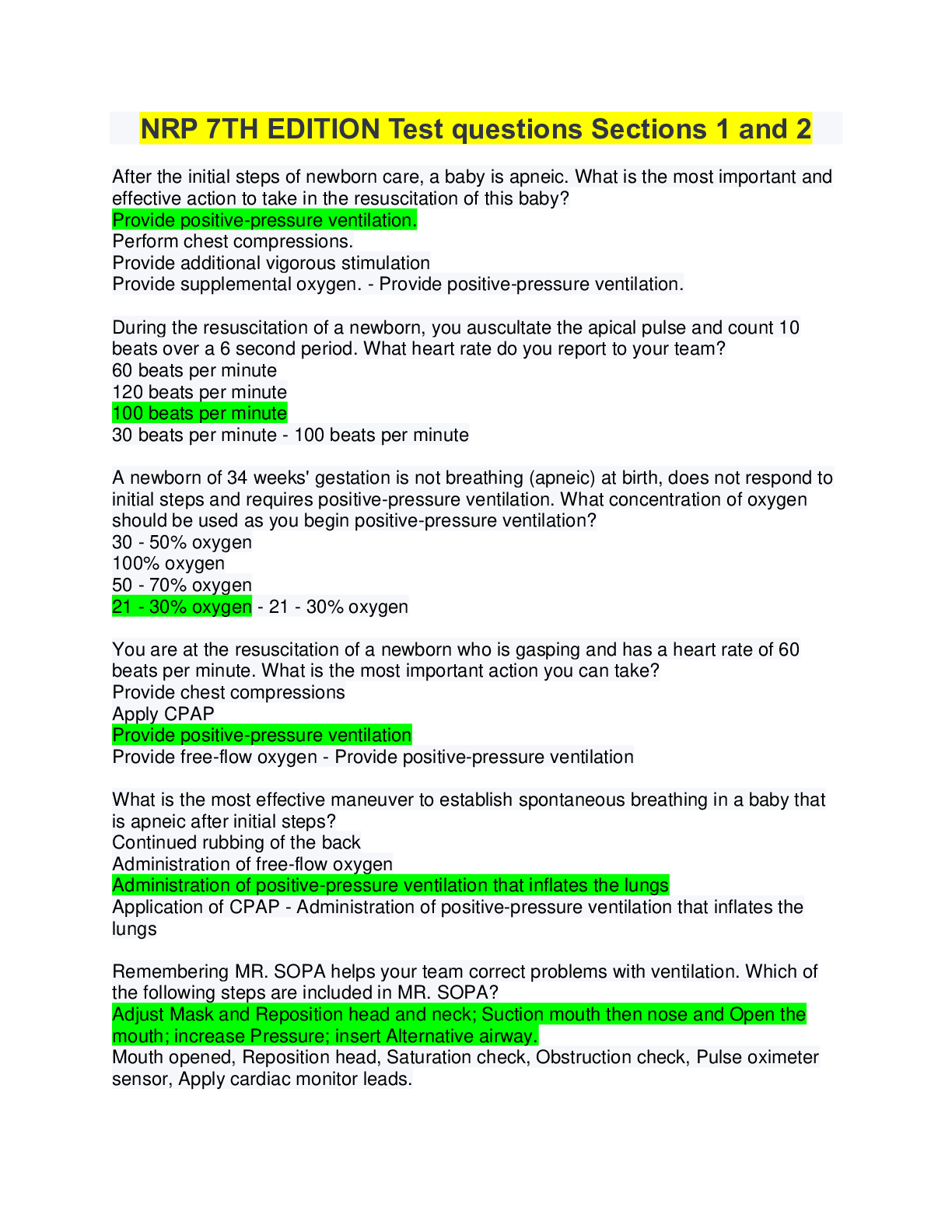
Reviews( 0 )
Recommended For You
*NURSING> EXAM > NRP 2022 exam/ NRP 7TH EDITION Parts 1 and 2 answered and graded 100% score. (All)
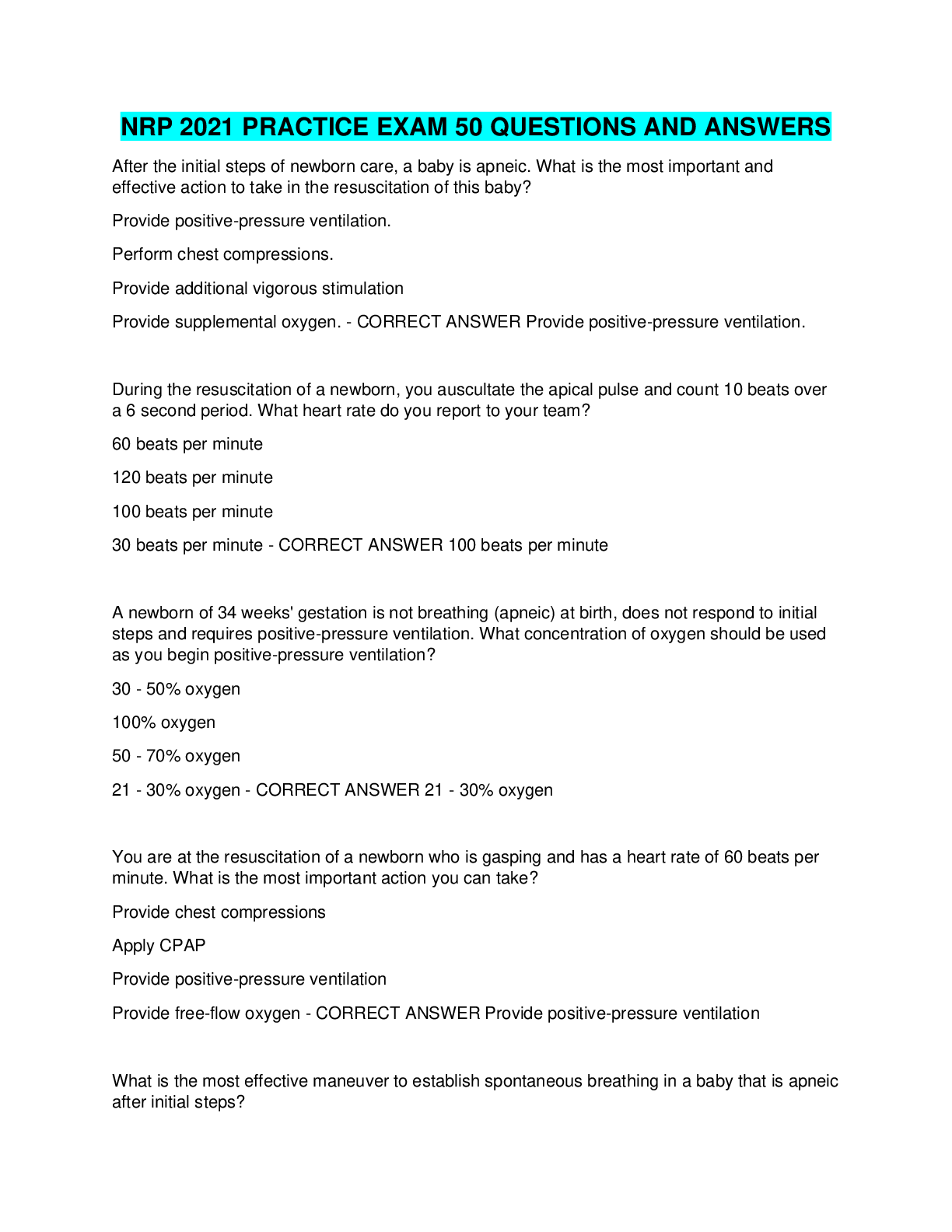
NRP 2022 exam/ NRP 7TH EDITION Parts 1 and 2 answered and graded 100% score.
NRP 7TH EDITION Test questions Sections 1 and 2 After the initial steps of newborn care, a baby is apneic. What is the most important and effective action to take in the resuscitation of this baby? Pr...
By DENNIS RIXX , Uploaded: May 18, 2022
$15.5
*NURSING> EXAM > NRP EXAM 7th EDITION PARTS 1 & 2 (All)
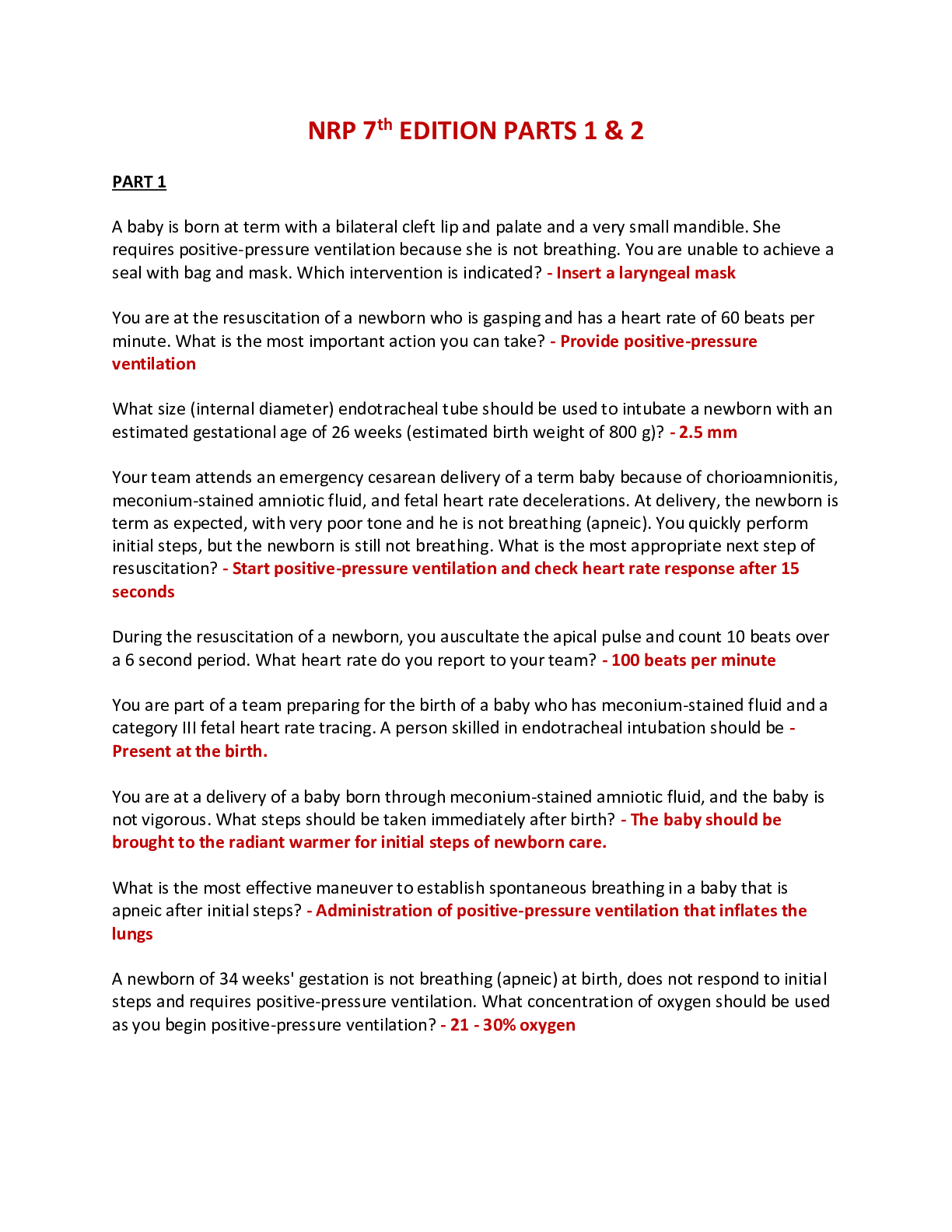
NRP EXAM 7th EDITION PARTS 1 & 2
NRP Exam 7TH EDITION Parts 1 & 2 Q&As-A baby is born at term with a bilateral cleft lip and palate and a very small mandible. She requires positive-pressure ventilation because she is not breathing. Y...
By Ajay25 , Uploaded: May 19, 2022
$15
*NURSING> EXAM > NRP 2022 Exam 7TH EDITION Parts 1 & 2 Q&As (All)
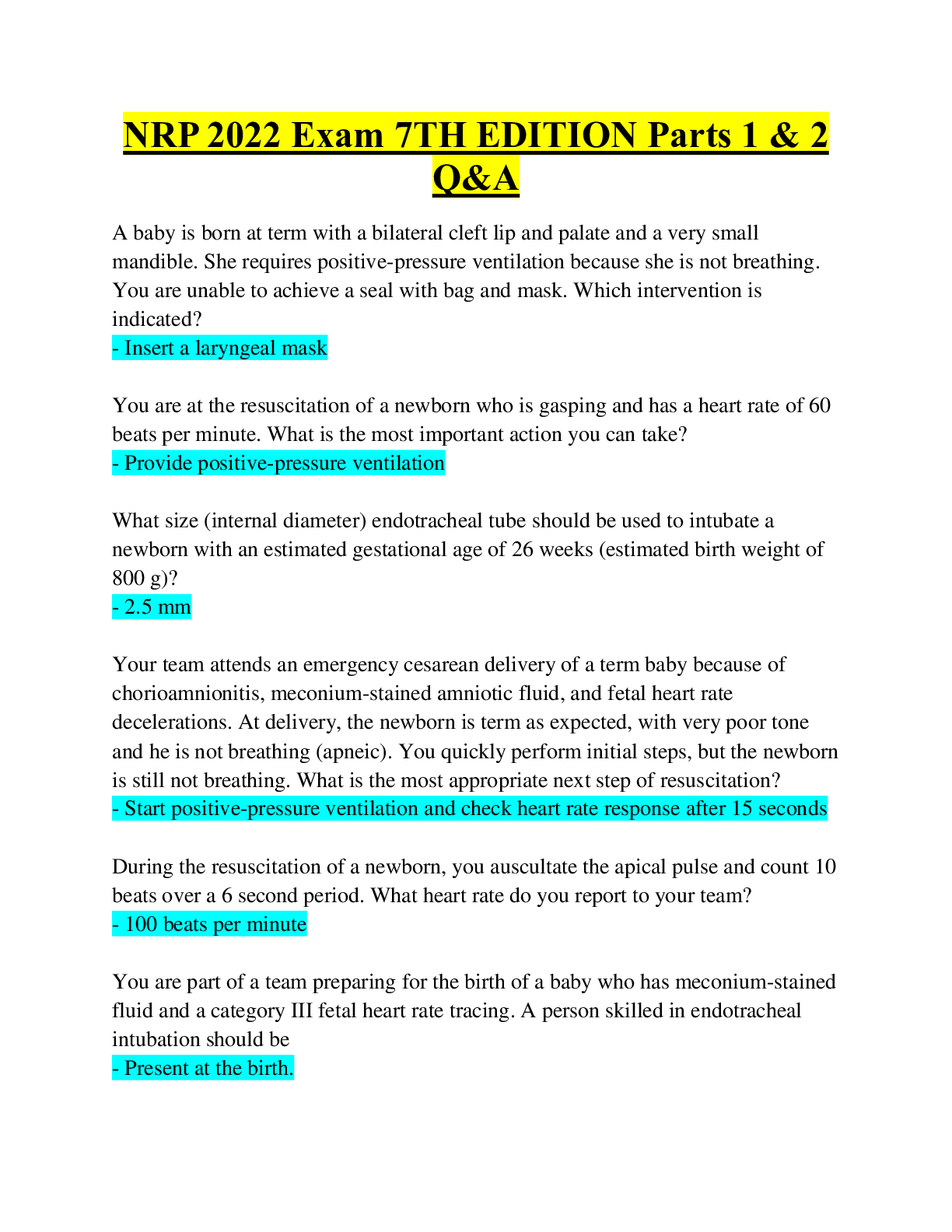
NRP 2022 Exam 7TH EDITION Parts 1 & 2 Q&As
NRP 2022 Exam 7TH EDITION Parts 1 & 2 Q&As-A baby is born at term with a bilateral cleft lip and palate and a very small mandible. She requires positive-pressure ventilation because she is not breathi...
By PROF , Uploaded: May 18, 2022
$13.5
*NURSING> EXAM > NRP 2022 exam/ NRP 7TH EDITION Parts 1 and 2 answered and graded 100% score. (All)

NRP 2022 exam/ NRP 7TH EDITION Parts 1 and 2 answered and graded 100% score.
NRP 7TH EDITION Test questions Sections 1 and 2 After the initial steps of newborn care, a baby is apneic. What is the most important and effective action to take in the resuscitation of this baby? Pr...
By Rixx Dennis , Uploaded: May 18, 2022
$15
*NURSING> EXAM > Test Bank for Nursing Leadership and Management Retakes_ 2021/ answered and graded 100% CORRECT GUARANTEED GRADE A+ (All)
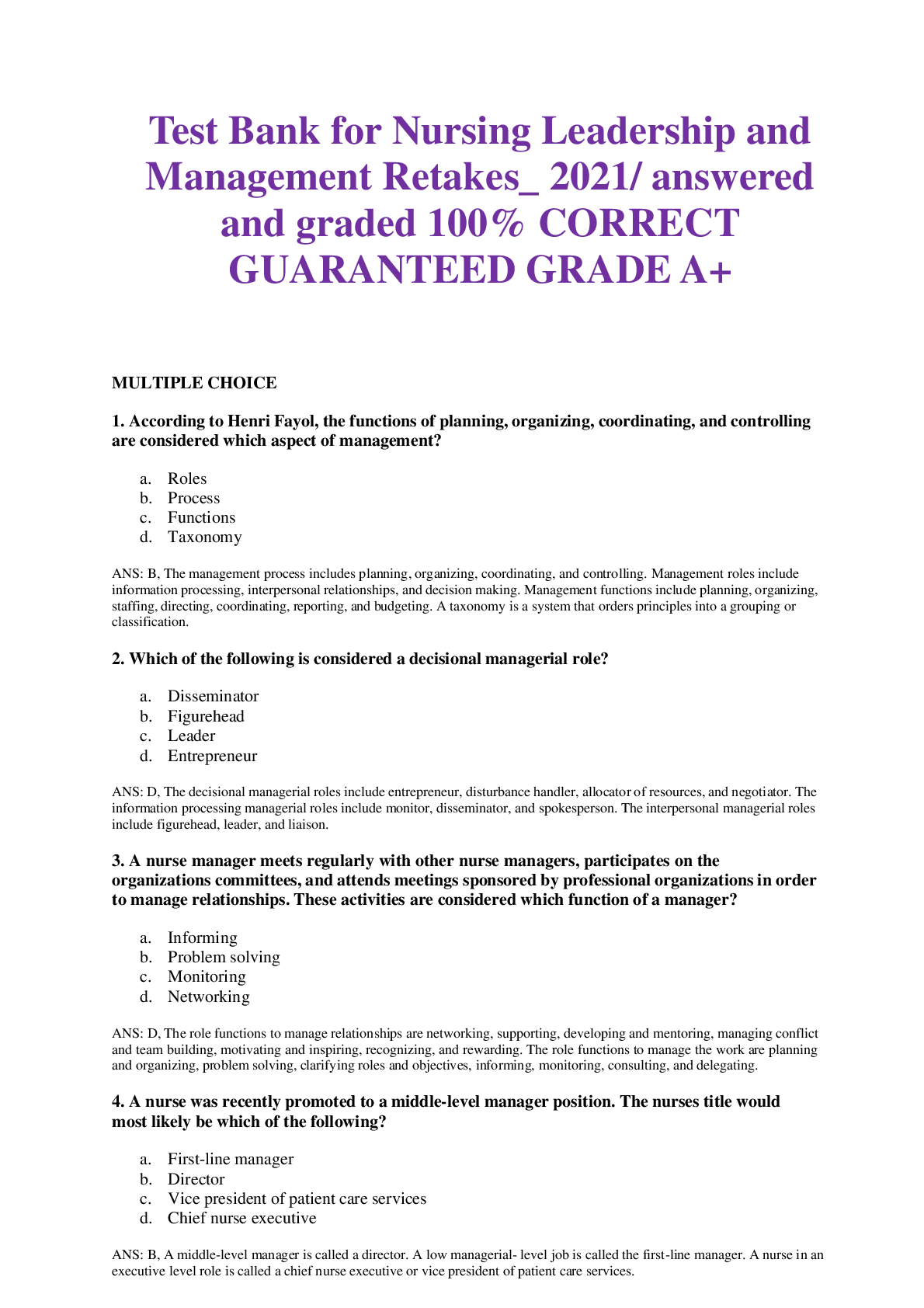
Test Bank for Nursing Leadership and Management Retakes_ 2021/ answered and graded 100% CORRECT GUARANTEED GRADE A+
1. According to Henri Fayol, the functions of planning, organizing, coordinating, and controlling are considered which aspect of management? a. Roles b. Process c. Functions d. Taxonomy ANS:...
By Allan100 , Uploaded: Oct 18, 2021
$19
*NURSING> EXAM > fresenius medical care PCT test rated and graded 100% Correct (All)
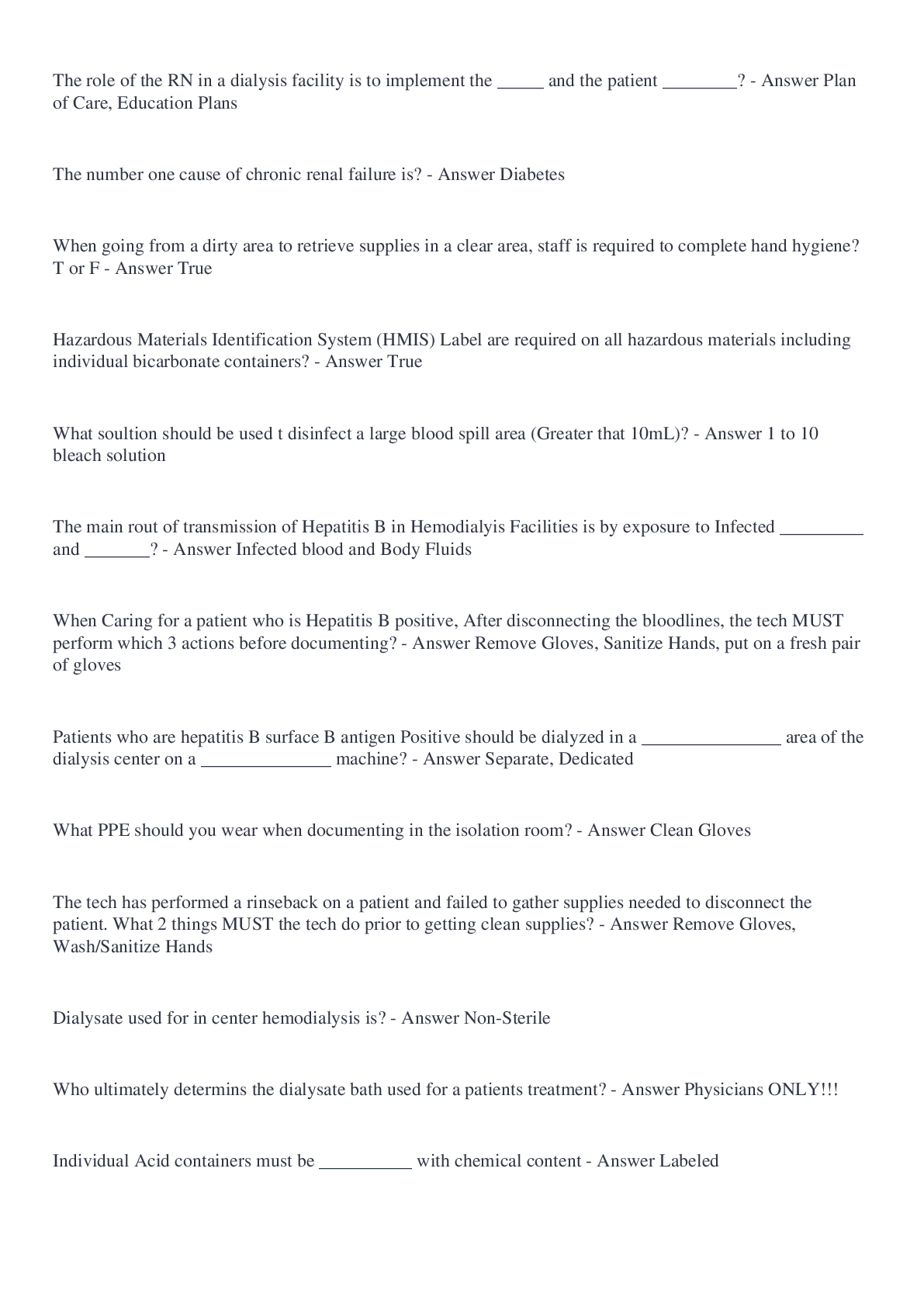
fresenius medical care PCT test rated and graded 100% Correct
The role of the RN in a dialysis facility is to implement the _____ and the patient ________? - Answer Plan of Care, Education Plans The number one cause of chronic renal failure is? - Answer Diabe...
By Dr Medina Reed , Uploaded: Aug 30, 2023
$10
Health Care> EXAM > Ethics for Health Professions HCA-200 Final Exam Questions with Answers 100% Correct (All)
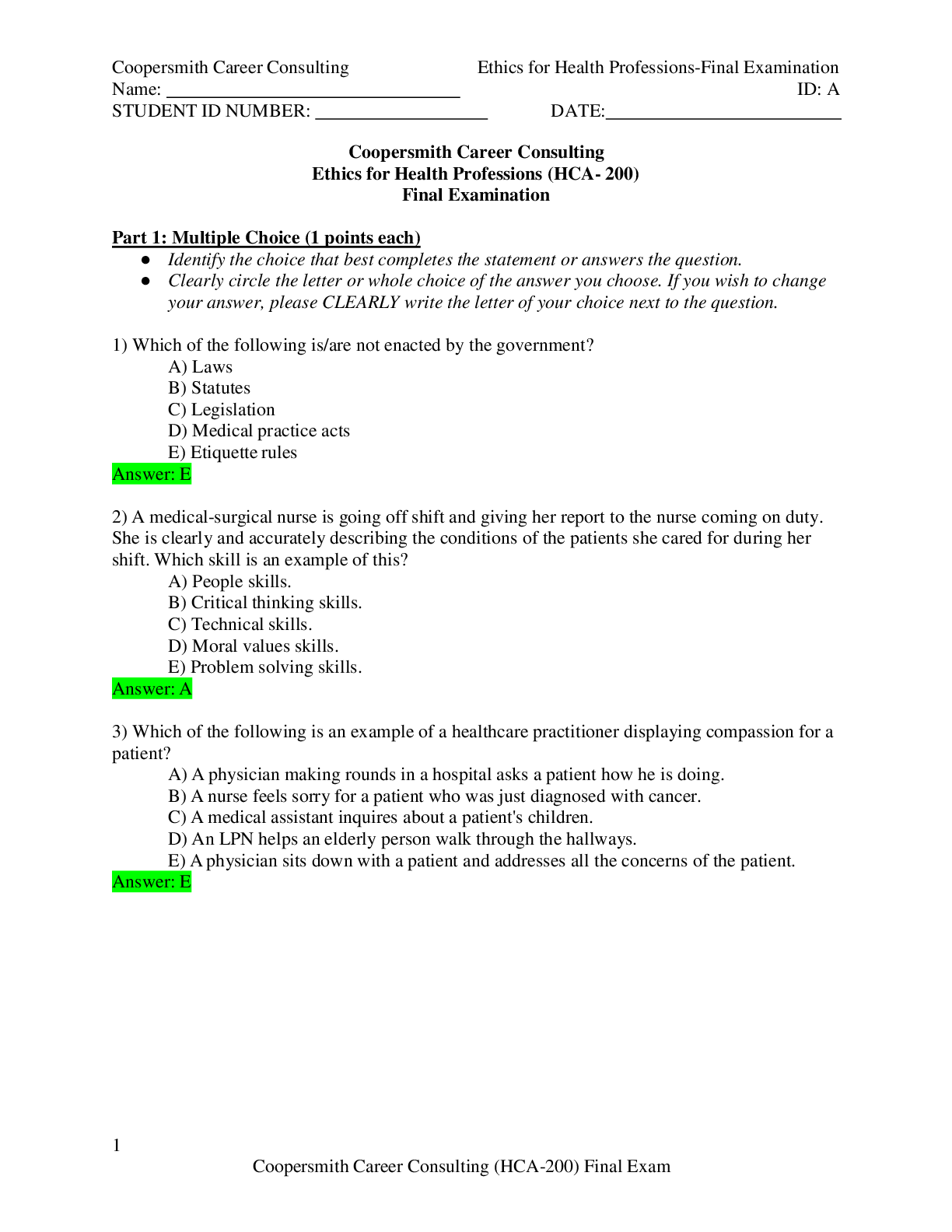
Ethics for Health Professions HCA-200 Final Exam Questions with Answers 100% Correct
Ethics for Health Professions (HCA- 200) Final Examination Part 1: Multiple Choice (1 points each) ● Identify the choice that best completes the statement or answers the question. ● Clearly circ...
By Quiz Merchant , Uploaded: Apr 19, 2021
$9
*NURSING> EXAM > ENPC Test Questions & Answers (All)

ENPC Test Questions & Answers
ENPC Test Questions & Answers-An unresponsive 2-year-old child was found by his mother with a bottle labeled "Elavil 50 mg" by his side. Which piece of information is important to obtain from his moth...
By PROF , Uploaded: Apr 25, 2024
$9.5
Religious Studies> EXAM > CWV TOPIC 2 QUIZ. QUESTIONS AND ANSWERS LATEST UPDATED. (Score 100%) (All)

CWV TOPIC 2 QUIZ. QUESTIONS AND ANSWERS LATEST UPDATED. (Score 100%)
CWV TOPIC 2 QUIZ QUESTIONS AND ANSWERS LATEST UPDATED
By ELIANA , Uploaded: Aug 01, 2022
$9
ATI MED SURG PROCTORED> EXAM > Med Surg ATI Proctored Exam Test Bank 2023/2024 With NGN (All)

Med Surg ATI Proctored Exam Test Bank 2023/2024 With NGN
Med Surg ATI Proctored Exam Test Bank 2023/2024 With NGN Med Surg ATI Proctored Exam Test Bank 2023/2024 With NGN Med Surg ATI Proctored Exam Test Bank 2023/2024 With NGN Med Surg ATI Proctored E...
By EXAMHUB SOLUTIONS , Uploaded: Apr 15, 2024
$30.5
Document information
Connected school, study & course
About the document
Uploaded On
May 07, 2022
Number of pages
11
Written in
Additional information
This document has been written for:
Uploaded
May 07, 2022
Downloads
0
Views
367






